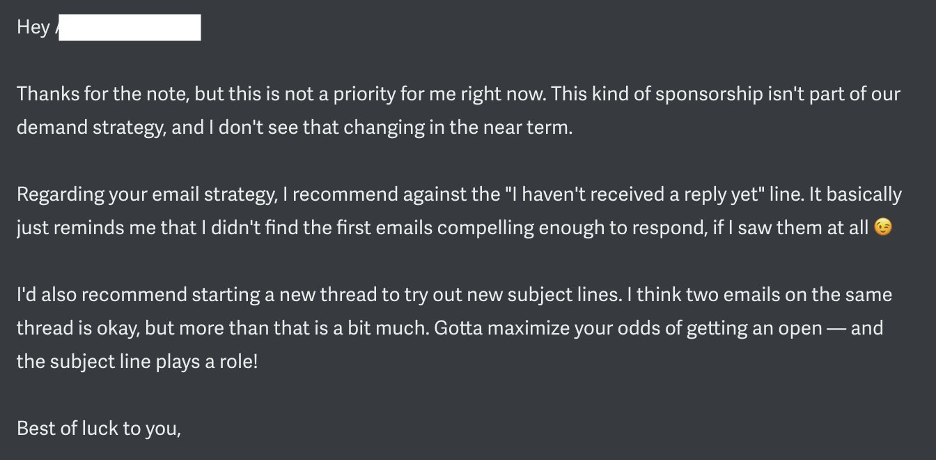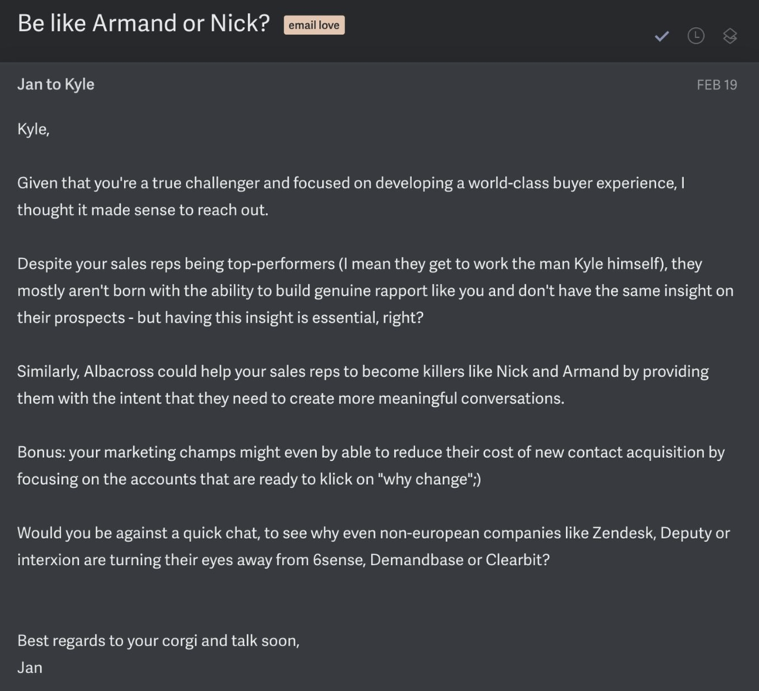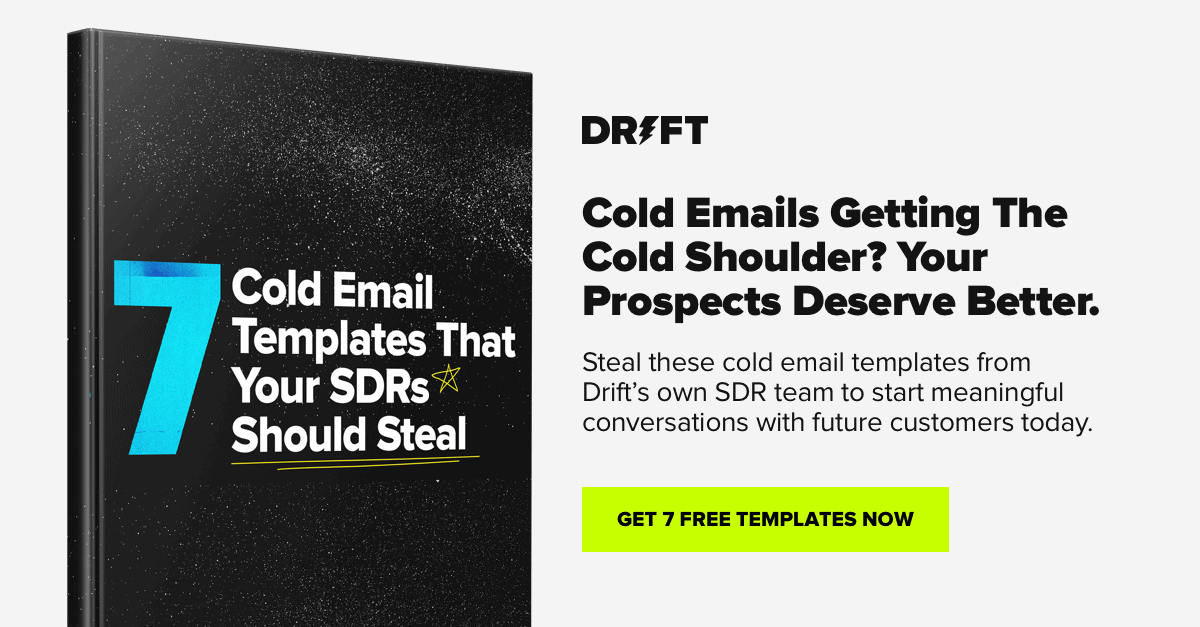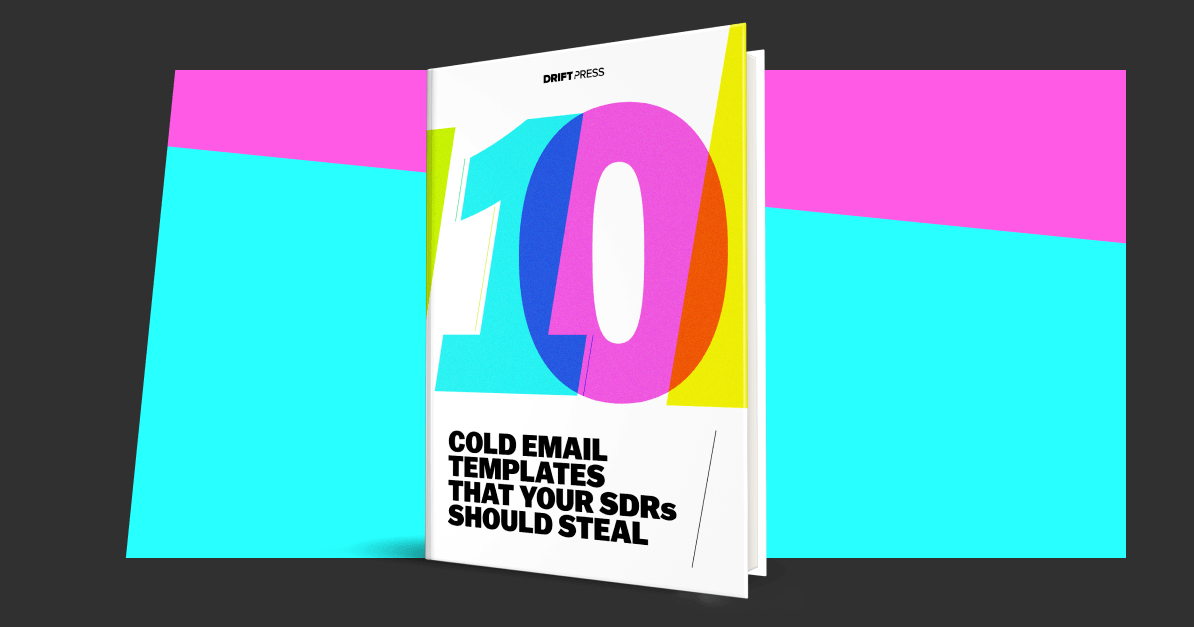I used to only respond to the good ones. To the salespeople who took the time to learn about me, my role, my company, and my goals. Then used that research to craft a truly personalized email catered to me.
That said, those types of cold sales emails are few and far between. Accounting for about 2% of the emails in my inbox. The other 98%? Those went straight into email purgatory.
At first, I thought I was doing a service – rewarding the right people and implicitly encouraging the others to step up their game.
But I realized that the folks I was ignoring were those who needed my help the most. And that I could help them improve much more proactively – if I responded.
Servant leadership is in my DNA. I’ve been fortunate to work with countless people who have gone out of their way to help me, and I enjoy paying it forward. That intrinsic motivator is why I love working in sales enablement, and is my animating purpose for being active on LinkedIn.
So I decided to respond to every cold sales email that came my way. It’s been a few weeks since I’ve started this campaign. But since then, I’ve learned a lot.
Common Mistakes Sales & SDRs Make in Cold Outreach
Messaging to cold leads is fundamentally different than messaging to warm ones. The latter group is, by definition, familiar with your solution and has expressed at least a bit of interest in learning more.
The former group, however, may not only be unfamiliar with your solution – they may not even know that your company exists. They’re not raising their hand and they’re not expecting to hear from you.
Despite this fact, the most pervasive theme I’ve seen in cold sales emails is the sender treating me like an inbound lead. Telling me everything about their company and how great their solution is, thinking that’ll compel me to book a meeting.
Often the copy seems to be pulled straight from the “About Us” section of their company’s website – marketing jargon and all. Here’s my response to this kind of cold outreach:

You have to create a compelling reason for your outreach. You reading my LinkedIn profile isn’t good enough.
When you’re reaching out cold to a lead, you have to convince me that you’re worth caring about. Here are a few examples that might compel me to respond or book a meeting:
- You found something I, my coworker, or my company said to be insightful.
- You understand the specific challenges me or my team are facing.
- You have a perspective on an industry trend that affects me / my company.
- You have knowledge about a competitor of mine that will pique my interest.
And this practice shouldn’t stop after the first email is ignored. SDRs and AEs have to find new or related reasons for their continued outreach.
Since I didn’t start out responding to every cold email, I was often on the receiving end of generic follow-ups. You’ve probably seen some version of this follow-up trope before:
- “Bubbling this back to the top…”
- “Checking in on my last email…”
- “Making sure you saw…”
Every email touch should add value, educate, and attempt to pique a buyer’s interest. None of these “bump” emails do any of that. They just remind me why I didn’t respond in the first place.
But, since I was turning over a new leaf, I started sharing feedback for follow-up emails as well:

What Great Cold Sales Emails Look Like
It hasn’t been all bad, though! I’ve gotten more than a handful of solid sales emails as well. People who studied the feedback I shared, took the principles to heart, and reworked their messaging.
Here’s one email that caught my attention – and earned a meeting. (I should mention, this sender and I have interacted a bit before, so there was some familiarity between us.)

The playful flattery is not why I responded. This is:
- Great research, a nice tie-in to the value prop, good call to action.
- Short, easy-to-read sentences with plain language.
- Plenty of white space to make it easy on the eye.
Jan, the sender, did an impressive “show me you know me” by highlighting specific things about my company, the pain points I was facing, and weaving in details about me personally. That made me interested in his company’s solution.
If the email above doesn’t make a ton of sense to you – that’s okay! It wasn’t written for you. It was written for me. That’s what personalization and effective cold emailing is all about.
Our team at Clari does an impressive job at this: Understanding the buyers they reach out to as both a persona and as a person. Here’s one of my recent favorites where the rep tied sales forecasting to bobsledding.
Let Your People Write
In my correspondence, I keep hearing something disappointing, but not altogether surprising: SDRs and AEs “aren’t allowed” to write their own emails. Instead, they’re sending emails written by their managers or their marketing team.
This cannot continue.
SDRs and AEs should be writing their own emails. They’re the ones on the frontlines with buyers, doing the research and the work. They need to be comprehensively trained on topics, trusted by management, and empowered to be themselves.
Some people may doubt that change is possible, but I couldn’t disagree more. The response from people I’ve engaged with has been overwhelmingly positive. And the rewrites and revisions I’ve seen are very encouraging.
Level Up Your Cold Sales Outreach Strategy
I hope more leaders will join me on this quest to improve cold email outreach and offer their expertise to sales folks on the frontlines.
It’s time for people at my level to stop complaining, stop shaming, and try to provide constructive feedback. You’ll get fewer emails, better emails, and you’ll discover solutions that will help your business along the way.
If you’re interested in becoming a better cold email writer or in training your team to do so, check out my fuller guide to personalization.
Cold sales prospecting takes time and practice. It takes an openness to failure and learning. But above all, it takes a fundamental change in mindset.
Cold outreach is not just a numbers game. Prospects are people, not just personas. Prospecting is a strategic endeavor. And the people and companies that adopt this mindset are going to be the ones who enjoy the lion’s share of success.
Kyle’s foray into B2B technology sales started in 2013 when he joined Looker as their sixth employee. Over the next six years, he grew Looker’s SDR team from one to 60-plus employees as the company scaled from $100k in ARR to over $100m, and was acquired by Google for $2.6b. Kyle is now the VP of Revenue Growth & Enablement at Clari, an AI-driven revenue operations and sales analytics platform. There he leads the growth marketing, SDR, and enablement teams. He’s an avid runner, a proud corgi owner, and is always looking to talk shop and trade best practices. Want more insights from Kyle? Follow him on LinkedIn. But, you gotta put in the work to find his email address 😉









